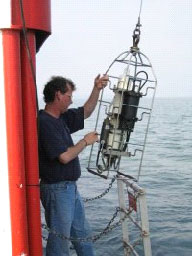Last month’s “Seventh Symposium on Harmful Algae in the U.S.” held in Sarasota, Fla., highlighted an NCCOS project that developed an integrated alert system to monitor and detect toxic cyanobacteria blooms in Lake Erie, Lake Ontario, and Lake Champlain.

The Monitoring and Event Response for Harmful Algal Blooms Program in the Lower Great Lakes (MERHAB LGL) project, which was funded by NCCOS from 2002 to 2008, organized six different working groups, each with their own tasks: cyanobacteria monitoring, toxin chemistry, new detection methods, hydrodynamic modeling, remote sensing, and outreach.
This tier-based system continued after NCCOS funding ended, and the project remains active in all three lakes. Further, the project established a regional toxin analysis service at the State University of New York -College of Environmental Science and Forestry (SUNY -ESF). The MERHAB LGL laboratory continues to assist local, state, and federal investigators and monitoring agencies throughout the Great Lakes region. Agencies often submit water samples for cyanobacterial toxicity analysis and use the lab’s results to minimize the impacts of toxic algal blooms.
For more information, contact Marc.Suddleson@noaa.gov.
